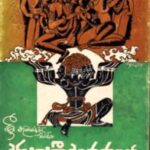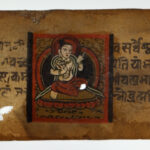As an appropriate aside to our recent article on the History of Sangeeta, is a Post on a particular work of Literature said by some to pre-date the work of the great Bharata Muni himself.
The Dattilam of Dattila is an oft-cited but little known work on Ancient Indian Music that, even more than the music theory it covers, is critical for what it actually represents.
Author
In his seal for brevity, Dattila becomes so laconic in his descriptions that they often read like obscure mathematical formulae. Fortunately, Bharata and also later authors have given details enabling us to interpret Dattila meaningfully. [1, 143]
Not much is known about the eponymous author of the Dattilam. Though the composer ends with a standard colophon announcing his name, he does not provide the traditional background and lineage one is used to encountering in such works. Like Bharata before (or after) him, he is more concerned with the content.
One of the reasons for the ambiguous speculation regarding Dattila’s contemporaneity with Bharata is because Bharata muni himself refers to the text Dattilam. At the same time, one of the one hundred sons list by him includes a Dattila. Was this a namesake of the original or the original himself? All this leads to the conclusion that it is best to avoid assertion where nothing is concrete.
Nevertheless, we know Dattila and his text are indeed authentic and influential as none other than the great Acharya Abhinavagupta refers to him and even quotes from the Dattilam. [1, 49]

The author sets out to describe not only what gandharva is but its purpose as well. He tells us of 18 jatis (proto-melodies) and 7 gitikas (structured song forms) and the importance of pada (words) and taala (beat pattern).
We see many of these common elements in Natya Sastra as well indicating the common tradition from which both Dattila and Bharata were working from.
Composition

The work begins with the traditional invocation to deity. It too ultimately is constructed upon the foundation of the Saama Veda.
Consisting of 244 slokas, Dattilam is divided into a preamble, two sections, and twelve chapters, with topics ranging from technical aspects of tala and varna to methodology suggested by others. It is a terse and aphoristic treatise, that reads as a manual for experts, rather than an introduction to students. As the translator of the current edition himself notes, it not only requires the use of later texts (such as Natya Sastra or Sangeeta Ratnakara) but also begs a commentary. So concise is the text that a number of scholars have suggested that it is only part of a greater work. Irrespective…
The Dattilam is a very suitable starting point for research into the theory of ancient Indian music, as it is a concise compendium of almost all the musical terms. [3, 5]
The manuscriptology behind the Dattilam is an interesting story in and of itself. Found in a collection sponsored by Travancore’s Royal Family, it was discovered by the curator, Pandit K. Sambasiva Sastri. The manuscript he came upon was attached to a copy of the Sangeetasamayasaara. It is said to have been written in Sanskrit with Malayalam script.
The first translation into English was by a Dutch scholar named Nijenhuis. A subsequent one also conducted by a Dutchman, with the present one completed by Mukund Lath. All of them are in effective agreement however that…
Dattilam assumes a series of purvacaryas, preceding masters, and specifically names three: Narada, Kohala and Visakhila. [1, xii]
This is an important point as it establishes the existence of a tradition prior to even Bharata muni (who himself refers to previous musical masters). Dattila, does not refer to Bharata, leading to the conclusion that they were both from the same time period, or Dattila was likely senior. While Natya Sastra is presently dated to 400-100 BCE, the Dattilam is at least as older if not older.
Further evidence adduced to this point is that the text is seen as rather independent of Bharata. Nevertheless…
gandharva stands for ‘music’—all music. But the gaandharva Dattila speaks of was a specific body of music, a sacred form. It was conceived as akin to a musical yajna, and like a yajna, it could result in transcendental merit (adrsta) leading to svarga. [1, xiii]
As such, whether it is Bharata or Dattila, it is clear that the sacred is not only the origin of music, but very much immanent in the Indic musical tradition.
Another point of interest is Dattila’s reference to various regions and musical aspects attached to regions. He makes frequent mention of jatis called udeecyava (meaning from the north), and also refers to andhri (Andhra), takka raga (from NW Punjab), maalavi (from Malava/Malwa), kambhoji (from ancient Kambhoja), gaudi (from Gauda/Bengal), and gandhara jatis, in verses 70-79. [1, 117]
Other concepts beyond jati discussed include varna. “Varna was the general term used to indicate musical or melodic movement over notes.” [1, 125] Varnas are inextricably linked to padas (words) in a gita (song). In contrast, a jati is of pure note structure, laying the foundation for later ragas. Tala (a term meaning beat or beat pattern) is also discussed. It is a time measure based on beats ensuring the note (svara) was saamya (in equilibrium).
Dattilam is a fine example of a saastric text and is of living value to us in that respect. It has striking affinities of approach and spirit with many other saastras, such [a]s those of Paanini on grammar, Pingala on the science of metrics and Tandu on the dance-form taandava. [1, xiv]
Selections

I. [Pranamya paramesaanam] Brahmaadhaamscha gurumstatha |
Gaandharva-saastra-sankshepah saarathoyam mayochyathe || sl. 1
[After having made my obeisance to the Supreme Lord] and to all the gurus, the first of whom is Brahmaa, I shall now enunciate in its essence the saastra concerning gaandharva in a concise form. [1, 1]
§
II. Gandharvam naaradaadibhyah pratthamaadhau svayambhuvaa |
vidhidan-naaradenaatha prithivyaam-avathaaritam || sl.2
The origin of gaandharva
Svayambhoo (the self-born one) gave gaandharva to Naarada and other sages. Narada, then, duly brought it down to this earth. [1,1]
§
III. Padasthah svarasamghaathas thaalena sumithas thathha |
Prayuktas-chaavadhaanena gaandharvam-abhidheeyathe || sl.3
What is gaandharva
A group of svaras, well-measured through taala and set to padas (words) when rendered with due attention (avadhaana) is called gaandharva. [1,1]
§
IV. Sruthayotha-svaraa graamau moorchanaas-thaana-samyuthaah |
Sthaanaani vruttayaschaiva sushkam saadhaarane thathha || sl.6
Jaathayaschaiva varnascha naana-alangkaara-samyuthaa |
Esha svara-gathodhreshah samskhepenaatha nirnayah || sl.7
Next, micro-intervals(sruthi), notes (svara), the two-tone systems (graama), scales (moorchanaa) consisting of series of notes (taana), the registers (sthaana), styles (vrtti), pure instrumental music (sushka), and the two ways of overlapping
modes (jaati) and ways of ornamentation (varna) connected with various graces (alamkaara). This is a mere description of the things relating to the notes…[3,2]
§
V. This exposition is no more than a pointer towards the system of the earlier acaryas. The knowing expert (sudhee) should look up their views and reach his own conclusions if he still has any doubts. sl. 244
Iti Dattilam samaaptam
Dattila (thus) composed a saastra known by the name Dattilam [1, 47]
Click here to Buy this Book today!!!
References:
- Lath, Mukund & Ed. Kapila Vatsyayan. Dattilam. Delhi: IGNCA.1988
- Prajnanananda, Swami. A History of Indian Music. Volume 1. Calcutta: Ramakrishna Vedanta Math. 1997
-
Nijenhuis, Emmie te. Dattilam: A Compendium of Ancient Indian Music. Utrecht. 1970



